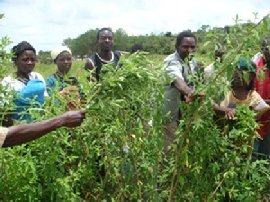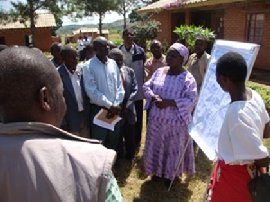Lecturer, Mzuzu University, Luwinga, Malawi
Research Interests
• Plant chemistry
• Natural products
• Medicinal plants
• Pesticidal plants
Web Page: African Dryland Alliance for Pesticidal Plant Technologies (ADAPPT): A network for optimising and promoting the use of indigenous botanical knowledge for food security and poverty alleviation in Africa
Project: Chemical composition and insecticidal properties of some plants used by small-scale farmers in Malawi for the control of field and storage insect pests. John Kamanula is an analytical plant chemist at Mzuzu University with broad interests in natural products, particularly from pesticidal and medicinal plants. He currently is a senior lecturer in chemistry and has managed a number of researched projects related to the proposed research project. He is familiar with extraction, isolation and identification of bioactive compounds from plant material. He also has a wide experience in evaluation of the efficacy of plant materials against storage insect pests of maize and beans. As part of a USAID NSF PEER grant, he will be spending 10 weeks at MBG where he will participate in the REU program. Stored crop and field losses caused by insect pests present some of the biggest threats to food security in Sub-Saharan Africa. Crop storage losses of 40-100 % have been reported in Malawi by researchers. These losses have adverse effects on food security, human nutrition and present major hurdles for attaining the Millennium Development Goals. Conventionally, farmers in Malawi use synthetic insecticides such as Actellic super dust, Shumba dust, Grain dust, phoskill, and dimethoate, among others, to control stored grain and vegetable insect pests. Although synthetic insecticides are usually effective, their use is associated with several problems. Most synthetic insecticides are (1) expensive to ordinary farmers, (2) persistent pollutants in the environment; (3) often adulterated, mislabelled or expired, making them difficult to use safely and reliably; and thus (4) prone to developing insect resistance. These problems with commercial synthetics can be overcome by using indigenous plant materials with pesticidal properties. African farmers perceive pesticidal plants as safe, cost-effective alternatives. Such plants can either be grown or collected locally, meaning the cost of use is measured in terms of labour to collect and process. Such natural materials naturally break down in soil or by ultraviolet light, cannot be adulterated when collected by the farmer, and reduce the development of insect resistance because several active ingredients are often acting together. Generations of farmers in Malawi have used plants for pest control, making the technology acceptable. However, the scientific evidence for the efficacy, correct dosage and application methods of the plant materials used by smallholder farmers is not fully understood. Many species of plant are collected from wild/semi-domestic habitats, and farmers do recognise the value of protecting the biodiversity of such habitats. However, the efficacy and correct application dosages of these plant materials and their extracts, mechanisms of sustainable harvesting and evaluation of the ecosystem services provided by such habitats is not well-developed in Malawi.
In the REU (MBG) project, one or two U.S. undergraduate students will evaluate the efficacy of some pesticidal plants used by farmers in Malawi for the management of storage insect pests of maize. They will also carry out phytochemical analysis of these plants using relatively simple analytical chemistry techniques.
Selected Publications
• Stevenson, P.C., Nyirenda, S.P., Mvumi, B.M, Sola, P., Kamanula, J.F., Sileshi, G.W., and Belmain, S.R (2012). Pesticidal plants: A viable Alternative Insect Pest Management Approach for Resource-poor Farming in Africa. In Opender et al., Botanicals in Environment and Food Security, Scientific Publishers, Jodhpur, India. (Book chapter, pp. 212-238).
• Belmain, S.R., Amoah, B.A., Nyirenda, S.P., Kamanula, J.F. and Stevenson, P.C. (2012). Highly Variable Insect Control Efficacy of Tephrosia vogelii Chemotypes. J. Agric. Food Chem, 60, 10055-10063.
• Kamanula, J., Sileshi, G., Belmain, S.R., Sola, P., Mvumi, B.M., Nyirenda, G.K.C., Nyirenda, S.P. and Stevenson, P.C. (2011). Farmers’ Insect Pest management practices and pesticidal plant use in the protection of stored maize and beans in Southern Africa. International Journal of Pest Management Vol. 57, No.1, January-March, 41-49.Muzemu, S. Mvumi, B.M., Nyirenda, S.P.M., Sileshi, G.W., Sola, P., Kamanula, J.F., Belmain, S.R. and Stevenson, P.C. (2011). Pesticidal effects of indigenous plants extracts against rape aphids and tomato red spider mites. African Crop Science Proceedings, Vol. 10, pp. 169-171.
 |
 |